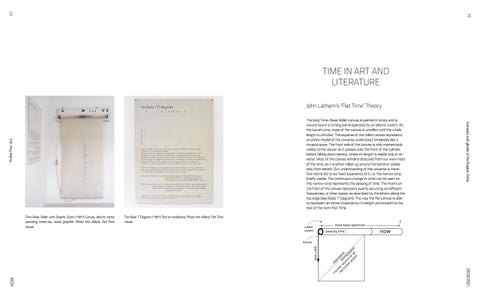77
77
TIME IN ART AND LITERATURE John Latham’s ‘Flat Time’ Theory
Andra Pop-Jurj
The Basic T Diagram (1991) Text on hardboard, Photo: Ken Adlard, Flat Time House
2020/2021
ADS8
Time-Base Roller with Graphic Score (1987) Canvas, electric motor operating metal bar, wood, graphite. Photo: Ken Adlard, Flat Time House
monsters and ghosts of the Russian Arctic
The long Time-Base Roller canvas is painted in strips and is wound round a turning barrel operated by an electric switch. As the barrel turns, more of the canvas is unrolled until the whole length is unfurled. The expanse of the rolled canvas represents an entire model of the universe understood timelessly like a musical score. The front side of the canvas is only momentarily visible to the viewer as it passes over the front of the cylinder before falling down behind, where its length is visible only in reverse. Most of the canvas remains obscured from our view most of the time, as it is either rolled up around the barrel or visible only from behind. Our understanding of the universe is therefore restricted to our lived experience of it, i.e. the narrow strip, briefly visible. The continuous change in what can be seen on this narrow strip represents the passing of time. The marks on the front of the canvas represent events occurring on different frequencies, or time-bases, as described by the letters along the top edge (see Basic T Diagram). The way the flat canvas is able to represent an entire Universe by it’s length and breadth is the root of the term Flat Time.






















